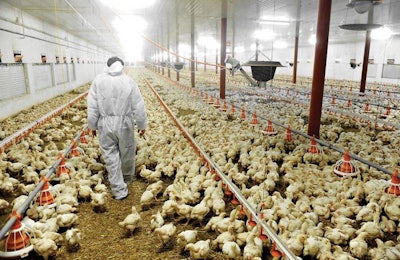
A new model for farm animal disease surveillance is being put into operation in Scotland.
Based on the recommendations of a review of disease surveillance in Scottish farm livestock, the new model has been announced by Scotland’s Rural College (SRUC), and combines individual advice to veterinarians with the use of big data, and integrated testing at a single laboratory.
Under the new proposal, veterinarians will send samples directly to the new SRUC Veterinary and Analytical Laboratory. At a cost of 1.6 million UK pounds (GBP; US$2.0 million), this facility is located at the Moredun Research Institute near Edinburgh.
The proposal also covers the establishment of a new disease intelligence center at the SRUC, where better use of data from passive surveillance aims to give farmers and veterinarians improved capabilities to predict when and where disease outbreaks are most likely to occur. This intelligence center will work closely with experts in epidemiology based at a new rural veterinary hub in Inverness.
Finally, farmers in all regions of Scotland are set to benefit from the proposed veterinary hub centers and local advice services. Using the latest diagnostic techniques, veterinarians at the SRUC will work with local practitioners to focus on animal health and productivity.
In Scotland, disease surveillance for farm animals is funded by the Scottish Government Veterinary Services Programme, and delivered by SRUC Veterinary Services.
It is expected that the new model for animal disease control will be fully operational by April of 2020.
Four existing post-mortem facilities are to be included within the new model. Two Scottish facilities have already closed, and another two will be shut by early next year.
“The challenge has been to create a new model of disease surveillance that provides the necessary amount of coverage within a reduced budget,” said George Caldow, Head of SRUC Veterinary Services. “This led us to look at how we use technology and new approaches to improve efficiency and proactively look at improving animal production. This model will allow the expertise available within SRUC to be harnessed more effectively for the benefit of all livestock production in Scotland.”
A total of 35 posts will be lost across Scotland as a result of the proposed changes to animal disease surveillance, according to the British Broadcasting Corporation (BBC).
In June of this year, SRUC opened a new avian innovation center, the largest research facility in the United Kingdom (U.K.) dedicated to improving poultry nutrition, health, and welfare. Offering the opportunity for controlled experimental conditions very similar to commercial practice, the center was officially opened the following month.
The reorganization of Scotland’s animal disease surveillance service comes at a critical time for livestock health globally, with the rapid spread of African swine fever (ASF) in Asia as well as central and eastern Europe, and the continued presence of avian influenza in poultry, among several other potentially devastating diseases.
A recent study by the University of Warwick in the UK found that nationwide or large-radius movement bans imposed after outbreaks of diseases such as foot and mouth disease (FMB), bovine tuberculosis (bTB), and bluetongue virus (BTV) cause unnecessary harm to the affected regions. More localized bans may be just as effective in preventing disease spread while limiting the adverse economic impacts, the researchers suggested.

















